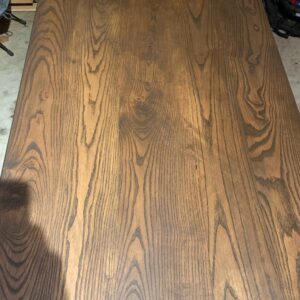Hey all – new to this forum and need some help troubleshooting. Thanks in advance.
Problem:
I just stained a 5/4 ash desk top with General Finishes Spiced Walnut (oil-based) stain, and am observing some noticeable streaking. See photo for reference.
Procedure I followed:
– Sanded with 80-,120-, 150- grit with random orbital sander
– Sanded with grain, slowly, one board at a time
– wiped with damp cloth between coats
– applied stain with brush, wiped off excess after applying (with the grain, one board at a time)
I observed the streaks immediately after wiping excess stain off. I was hoping it would fade after drying, but it is still very noticeable.
Any ideas on potential root cause? Any instructions on how to mitigate?
Thanks, Peter
















Replies
The streaks look to be in the "arm-arc" range of motion, and cross over multiple boards, so I'm guessing it is something you did.
My guess is "damp cloth between coats" when you were using an oil-based finishing product. The old saw "oil & water don't mix" is likely your culprit.
Add a coat of stain and let it site for a while before you wipe it off. If it does not even out, start sanding.
Makes total sense. Thanks so much for helping out, will try out your suggestion. If it doesn't even out after another coat - do I sand down to the raw wood and try again? Do I just sand affected areas or the whole top? - Thanks
I'd sand the whole thing, those streaks are an odd pattern and would be tough to blend. Sand with 180 until the streaks seem gone and wipe with a cloth damp with alcohol or mineral spirits to see if they pop under "finish". If you don't see them let the top dry out for a couple of days and sand back up to your final grit before restaining.
Thank you!!
+1. On what MJ said I’ve never be much much corecting things like this Best to start fresh.
Looks like a poor sanding job. Why are you sanding "one board at a time"?
Also, considering you put one coat of stain on it, "wiped with damp cloth between coats", I'll assume means you wiped with wet rag between grits? You only need to dampen the final sanding if using a water based stain or finish, and then lightly sand with fine paper to knock down the nibs.
You should start over. You can wipe with mineral spirits to remove some stain and maybe save a little paper.
Start with 80 again, work the entire top with overlapping strokes, with a random orbit sander start cross grain and finish with the grain. The majority of the work will be done with the initial grit, don't stop until all defects are sanded out and you have a consistent scratch pattern. A light (flashlight works) played low as well as sighting low over the surface will show up discrepancies. Moving too quickly to the next grit is tempting but a recipe for failure.
Once you are ready to move to the next grit, you are simply removing the previous scratch pattern so things will move along a bit quicker, but again, don’t move on until the scratch pattern is consistent.
Skipping grits is technically correct but you might want to sand through successive grits if you are not that experienced or at least 80-100-120 before you start skipping. I would also take it to 180.
When you stain, do the whole top- it’s not that big. Not one board at a time.
This forum post is now archived. Commenting has been disabled